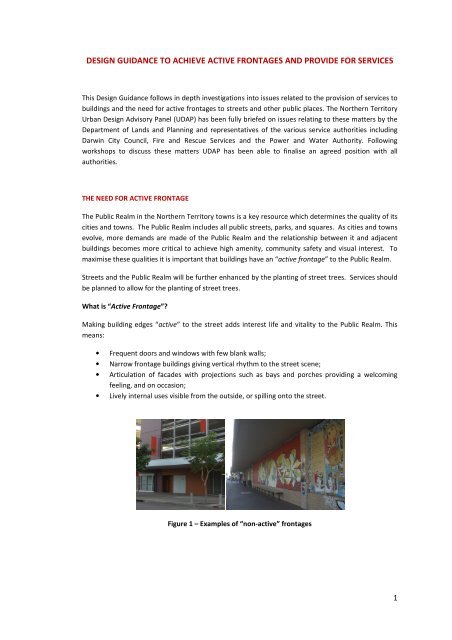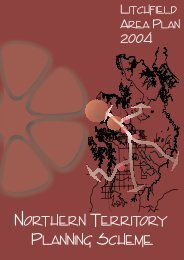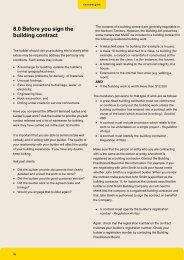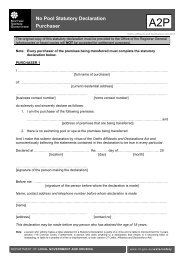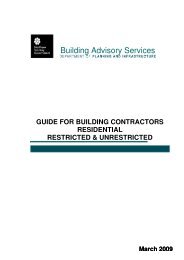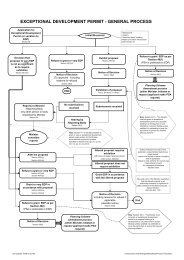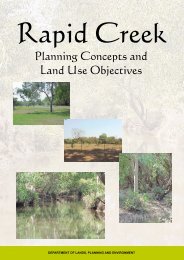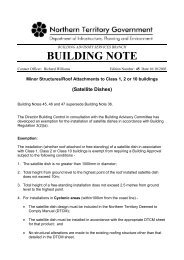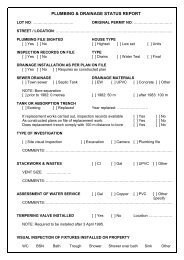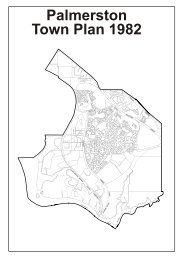design guidance to achieve active frontages and provide for services
design guidance to achieve active frontages and provide for services
design guidance to achieve active frontages and provide for services
Create successful ePaper yourself
Turn your PDF publications into a flip-book with our unique Google optimized e-Paper software.
DESIGN GUIDANCE TO ACHIEVE ACTIVE FRONTAGES AND PROVIDE FOR SERVICES<br />
This Design Guidance follows in depth investigations in<strong>to</strong> issues related <strong>to</strong> the provision of <strong>services</strong> <strong>to</strong><br />
buildings <strong>and</strong> the need <strong>for</strong> <strong>active</strong> <strong>frontages</strong> <strong>to</strong> streets <strong>and</strong> other public places. The Northern Terri<strong>to</strong>ry<br />
Urban Design Advisory Panel (UDAP) has been fully briefed on issues relating <strong>to</strong> these matters by the<br />
Department of L<strong>and</strong>s <strong>and</strong> Planning <strong>and</strong> representatives of the various service authorities including<br />
Darwin City Council, Fire <strong>and</strong> Rescue Services <strong>and</strong> the Power <strong>and</strong> Water Authority. Following<br />
workshops <strong>to</strong> discuss these matters UDAP has been able <strong>to</strong> finalise an agreed position with all<br />
authorities.<br />
THE NEED FOR ACTIVE FRONTAGE<br />
The Public Realm in the Northern Terri<strong>to</strong>ry <strong>to</strong>wns is a key resource which determines the quality of its<br />
cities <strong>and</strong> <strong>to</strong>wns. The Public Realm includes all public streets, parks, <strong>and</strong> squares. As cities <strong>and</strong> <strong>to</strong>wns<br />
evolve, more dem<strong>and</strong>s are made of the Public Realm <strong>and</strong> the relationship between it <strong>and</strong> adjacent<br />
buildings becomes more critical <strong>to</strong> <strong>achieve</strong> high amenity, community safety <strong>and</strong> visual interest. To<br />
maximise these qualities it is important that buildings have an “<strong>active</strong> frontage” <strong>to</strong> the Public Realm.<br />
Streets <strong>and</strong> the Public Realm will be further enhanced by the planting of street trees. Services should<br />
be planned <strong>to</strong> allow <strong>for</strong> the planting of street trees.<br />
What is “Active Frontage”?<br />
Making building edges “<strong>active</strong>” <strong>to</strong> the street adds interest life <strong>and</strong> vitality <strong>to</strong> the Public Realm. This<br />
means:<br />
• Frequent doors <strong>and</strong> windows with few blank walls;<br />
• Narrow frontage buildings giving vertical rhythm <strong>to</strong> the street scene;<br />
• Articulation of facades with projections such as bays <strong>and</strong> porches providing a welcoming<br />
feeling, <strong>and</strong> on occasion;<br />
• Lively internal uses visible from the outside, or spilling on<strong>to</strong> the street.<br />
Figure 1 – Examples of “non-<strong>active</strong>” <strong>frontages</strong><br />
1
Figure 2 – Examples of good “<strong>active</strong> frontage”<br />
BACKGROUND<br />
As part of the building heights amendment <strong>to</strong> the NT Planning Scheme a section on urban<br />
<strong>design</strong> requirements was added <strong>to</strong> supplement the building heights at or near ground level<br />
along the pedestrian footpaths.<br />
One of these requirements was that all developments are <strong>to</strong> have at least 75% of their<br />
building frontage <strong>to</strong> be <strong>active</strong> where practical. The requirement of 75% evolved from<br />
discussions within the Urban Design Advisory Panel.<br />
Over a period of time several Development Applications have been submitted <strong>and</strong> generally<br />
buildings with <strong>frontages</strong> less than 30 metres were unable <strong>to</strong> meet the requirement of 75%<br />
<strong>active</strong> street frontage. The primary impediment is the requirement on building facades <strong>and</strong><br />
along site <strong>frontages</strong> <strong>for</strong> <strong>services</strong>. The <strong>services</strong> that prevented the <strong>achieve</strong>ment of <strong>active</strong><br />
street frontage were:<br />
• Electrical Sub Stations<br />
• Meter Rooms<br />
• Water Meters<br />
• Sprinkler <strong>and</strong> Fire Booster Rooms<br />
• Waste collection<br />
• Egress <strong>and</strong> Access Driveways<br />
• Bus S<strong>to</strong>ps<br />
In order <strong>to</strong> fully underst<strong>and</strong> the impact service authority requirements were having on the<br />
ability <strong>to</strong> <strong>achieve</strong> activation of the street <strong>frontages</strong> <strong>to</strong> buildings, the Development Consent<br />
Authority (DCA) requested that the Department of L<strong>and</strong>s <strong>and</strong> Planning – (Strategic Planning)<br />
undertake a study. This study <strong>for</strong>med the background <strong>to</strong> workshops conducted by UDAP<br />
with service authorities <strong>and</strong> the Department of L<strong>and</strong>s <strong>and</strong> Planning.<br />
BACKGROUND TECHNICAL INFORMATION<br />
From the study conducted by the Department of L<strong>and</strong>s <strong>and</strong> Planning, the following technical<br />
requirements were obtained from the various service authorities:<br />
Electrical Services<br />
A. Main Objectives<br />
• Good Access <strong>and</strong> Egress <strong>to</strong> equipment;<br />
• Safety.<br />
2
B. General Requirements<br />
• Do not want package electrical substations in CBD;<br />
• Could be unstable when open <strong>to</strong> the elements;<br />
• Needs an enclosure of approximately 4m x 4m x 3m.<br />
C. Size of Equipment (Electrical Trans<strong>for</strong>mers)<br />
• St<strong>and</strong>ard Size 2m x 2m x 2.5m high. Weigh up <strong>to</strong> 2.4 <strong>to</strong>nes. Needs <strong>to</strong> be earthed;<br />
• Smaller types are used in other states.<br />
D. Sub Station Room Size<br />
• St<strong>and</strong>ard room size around 4m x 4m x 3m;<br />
• Requires two means of egress, one at least directly accessible <strong>to</strong> the outside;<br />
• Needs plenty of circulated ventilation (natural <strong>and</strong> mechanical);<br />
• Access by crane <strong>and</strong> truck (use of monorail) with 24 hours access;<br />
• All weather protection;<br />
• If two or more trans<strong>for</strong>mers are needed, then a room slightly larger than a st<strong>and</strong>ard room is<br />
preferred.<br />
E. Other Locations<br />
• First Floor generally acceptable locations but needs <strong>to</strong> be a dry system <strong>and</strong> it generates more heat<br />
<strong>and</strong> needs a higher ceiling.<br />
F. Associated Metering (Cus<strong>to</strong>mer Main Switch)<br />
• A room 4m x 4m (depending on layout), preferably behind the substation;<br />
• Needed <strong>for</strong> circuit breakers <strong>and</strong> meters. Note - meters are able <strong>to</strong> be read remotely.<br />
G. Management Issues<br />
• To introduce new <strong>design</strong> changes in<strong>to</strong> the organisation. A lengthy process is required which could<br />
take up <strong>to</strong> a year;<br />
• Also new backup equipment might be needed;<br />
• A process is should be <strong>for</strong>malised <strong>to</strong> confirm that developers <strong>and</strong> their agents have spoken <strong>to</strong><br />
service authorities be<strong>for</strong>e DCA approval is given;<br />
• Maintenance of a/c equipment is essential.<br />
2.5 m<br />
2 m<br />
2 m<br />
Electrical Trans<strong>for</strong>mer<br />
Electrical Trans<strong>for</strong>mer Room<br />
3
Fire Services<br />
A. Booster Pump Enclosures<br />
• Need pressure boost from fire appliances because water pressure is weak;<br />
• Controlled by AS 2419 Hydrant St<strong>and</strong>ard;<br />
• “H” system needs 2 m wide x 1 m deep enclosure with direct access from the street.<br />
B. Fire Control Rooms <strong>and</strong> Panels<br />
• Needed if building is over 50 metres in height (approx 10 sq metres in area);<br />
• Must be accessible from the street <strong>and</strong> the lift lobby as well as being fire rated;<br />
• Panels required if building is over 25 metres <strong>and</strong> needs <strong>to</strong> be within direct sight of control room;<br />
• Tanks <strong>and</strong> pumps can be in the basement.<br />
“H” Fire + Sprinkler Booster<br />
Fire Alarm Panels<br />
Water Services<br />
Fire A. Booster Water Meters Valve Generally<br />
• Expectation that there is a st<strong>and</strong>ard water meter arrangement <strong>to</strong> service all building<br />
developments;<br />
• Sometimes consists of both fire <strong>and</strong> domestic meters;<br />
• Vary in size from DN 20 <strong>to</strong> DN 225;<br />
• 4 Options available <strong>for</strong> orientation <strong>and</strong> location;<br />
• Requires access <strong>for</strong> maintenance <strong>and</strong> reading of meters.<br />
Bus Drop Offs<br />
“Water Pipe Metering<br />
A. Bus Drop Offs - Assumptions<br />
• That not all residential developments need a bus drop off (either on street or off street);<br />
• Large serviced apartments <strong>and</strong> hotels generally do need a bus drop off (either on street or off<br />
street);<br />
4
• Preferred locations <strong>for</strong> bus drop off are side streets or rear lanes if practical then the main street<br />
frontage (either on street or off street);<br />
• Sites in non-retail environments <strong>and</strong> with minimal street frontage should consider an on-street<br />
bus drop off <strong>and</strong> a car parking contribution in lieu of the lost car spaces in the street.<br />
Garbage Services<br />
B. Garbage Bin Pick Up<br />
• Darwin City Council prefers that garbage is picked up on site <strong>and</strong> that garbage vehicles enter <strong>and</strong><br />
egress the site in a <strong>for</strong>ward direction. Options <strong>for</strong> garbage pickup are being studied by the DCC.<br />
An urban <strong>design</strong> preference is <strong>for</strong> kerb-side garbage pickup, however this is not yet DCC policy;<br />
• In order <strong>to</strong> meet the requirement <strong>for</strong> onsite pick-up, developments are required <strong>to</strong> <strong>provide</strong> a large<br />
cross-over <strong>and</strong> sometimes porte-cocheres that disrupt footpaths <strong>and</strong> significantly restrict <strong>active</strong><br />
street <strong>frontages</strong>. This is an undesirable outcome in any urban context in the Northern Terri<strong>to</strong>ry,<br />
including in Darwin.<br />
DISCUSSIONS WITH SERVICE AUTHORITIES<br />
During the August 2011 meeting of UDAP, representatives from relevant service authorities were<br />
asked <strong>to</strong> discuss <strong>and</strong> present their requirements in the light of an overall desire <strong>to</strong> maximise “<strong>active</strong><br />
frontage” <strong>to</strong> streets.<br />
Representatives of Darwin City Council, Fire <strong>and</strong> Rescue Services, Power Water <strong>and</strong> the Department<br />
of L<strong>and</strong>s <strong>and</strong> Planning were present at these discussions.<br />
An agreed position was arrived at where all service authorities were able <strong>to</strong> state their positions <strong>and</strong><br />
agree on a way <strong>for</strong>ward. It was clear that there were no rules or legislation that dem<strong>and</strong> that fire<br />
booster assemblies (apart from the connection points), water meter assemblies, electrical substations<br />
or refuse collection be on a street frontage. The agreed position <strong>for</strong> all service authorities is<br />
as follows:<br />
Fire <strong>and</strong> Rescue Services<br />
• Boosters need <strong>to</strong> be accessible from the street <strong>for</strong> connection <strong>to</strong> fire appliances in<br />
emergencies;<br />
• No street furniture or trees should be located directly in front of the booster connec<strong>to</strong>rs;<br />
• Boosters should be a minimum 10m from electrical trans<strong>for</strong>mers;<br />
• Booster connections are the only items of equipment needing access from the street;<br />
• Booster assembly equipment can be located behind a wall or even in a basement;<br />
• The FIP (Fire Indica<strong>to</strong>r Panel) should be located in building foyers, a maximum 4m from the<br />
front door <strong>and</strong> preferably within sight of the booster connections;<br />
• Booster connections can be turned vertical <strong>to</strong> reduce impact on <strong>active</strong> frontage.<br />
Garbage Collection<br />
• Darwin City Council is examining options <strong>for</strong> garbage pickup including trucks collecting<br />
garbage without having <strong>to</strong> enter a site, i.e. kerbside pickup. This is not yet DCC policy;<br />
• Where on-site collection occurs this should be fully contained within the development <strong>and</strong><br />
vehicles should enter the same access points as other vehicles;<br />
5
Bus Drop-off <strong>and</strong> Pick-up<br />
• It was agreed that porte-cocheres can be a significant disruption <strong>to</strong> footpath continuity <strong>and</strong><br />
<strong>active</strong> frontage. For this reason on-street drop-off was preferred. This might require<br />
modification <strong>to</strong> kerbs <strong>and</strong> on-street parking outside short stay accommodation venues.<br />
Reduction of on-street parking in commercial areas is however undesirable. Developers are<br />
encouraged <strong>to</strong> approach the DCC <strong>and</strong> other councils early in the <strong>design</strong> process <strong>to</strong> address<br />
these issues.<br />
Electrical Services<br />
• While electrical substations are large, their location is relatively flexible;<br />
• Sub-stations require as much natural ventilation as possible there<strong>for</strong>e location above ground<br />
floor is optimal. Basement locations require significant mechanical cooling;<br />
• Maintenance <strong>and</strong> removal of trans<strong>for</strong>mers <strong>and</strong> high voltage switchgear are the key<br />
determining fac<strong>to</strong>rs of location.<br />
Water Services<br />
• Water metres can be located in basements or deeper within a site, i.e. back from a building’s<br />
facade;<br />
• Access should be <strong>provide</strong>d <strong>to</strong> water metres, <strong>and</strong> this should meet PowerWater st<strong>and</strong>ards;<br />
• Water pipes should preferably not be built in<strong>to</strong> building structure.<br />
Access <strong>and</strong> Egress<br />
• Access <strong>to</strong> basement parking is preferred from rear lanes, where they exist;<br />
• Fire escape exit doors must discharge <strong>to</strong> the street, either from upper floors or basements.<br />
From these discussions it has become clear that the only <strong>services</strong> which have <strong>to</strong> be located on<br />
building facades or along the site frontage are the fire appliance booster connection pipes, fire escape<br />
doors, <strong>and</strong> vehicle access. All other <strong>services</strong> are able <strong>to</strong> be positioned in other ways.<br />
It is however important that those <strong>services</strong> which require access from the service authorities have<br />
appropriate access routes planned in<strong>to</strong> the building.<br />
6
Design Guidance - the following service requirements should be met:<br />
Fire <strong>services</strong><br />
Small buildings Provide access <strong>to</strong> FIP (Fire Indica<strong>to</strong>r Panel) <strong>and</strong> boosters from the<br />
street. FIP should be in a foyer <strong>and</strong> a maximum 4m from the front<br />
door.<br />
Bigger buildings (Applies <strong>to</strong> buildings taller than 50m in height);<br />
Must have a fire control room. This must not be on the ground floor<br />
facade of the building;<br />
Direct <strong>and</strong> fire-rated access <strong>to</strong> sprinkler tanks, sprinkler valves <strong>and</strong><br />
fire control rooms must be <strong>provide</strong>d although this does not have <strong>to</strong><br />
be directly off the street;<br />
Booster connections should be turned vertical <strong>to</strong> reduce impact on frontage;<br />
Booster assemblies can be located elsewhere in the building;<br />
All other fire <strong>and</strong> rescue equipment may be in basements or elsewhere in the<br />
building.<br />
Electrical <strong>services</strong><br />
Electrical Sub-stations should preferably be located above ground floor level <strong>to</strong><br />
maximise passive cooling;<br />
Where there is a parking access ramp or entry, electrical substations should be<br />
located above these <strong>to</strong> facilitate removal by vehicles;<br />
Where electrical sub-stations are located in a basement, sub-stations must be airconditioned<br />
<strong>and</strong> access <strong>provide</strong>d <strong>for</strong> maintenance, replacement, <strong>and</strong> personnel<br />
escape. Where practical a lift should be <strong>provide</strong>d <strong>for</strong> replacement of deficient substations.<br />
Water <strong>services</strong><br />
Access <strong>to</strong> water metres must be <strong>provide</strong>d.<br />
Water metres may be located anywhere in the building but not on the building<br />
facade or frontage.<br />
Water pipes are preferably not <strong>to</strong> be built in<strong>to</strong> buildings but surface-mounted <strong>for</strong><br />
access.<br />
Space requirements <strong>and</strong> access specified by PowerWater are <strong>to</strong> be adhered <strong>to</strong>.<br />
7
Garbage collection<br />
While it is unders<strong>to</strong>od that the DCC are still examining options, UDAP recommends<br />
that garbage should be collected from the kerb, or;<br />
If garbage collection is on site, it needs <strong>to</strong> be fully contained within the development<br />
<strong>and</strong> utilise the same access as other vehicles <strong>and</strong> with all collection screened from<br />
view.<br />
Bus drop off<br />
Porte-cocheres should not be permitted, except in circumstances where large<br />
apartment complexes <strong>and</strong>/or serviced apartments or hotels are able <strong>to</strong> incorporate<br />
a porte-cochere with minimal impact on the public realm. This needs <strong>to</strong> be<br />
demonstrated. In all other circumstances, drop-off is <strong>to</strong> be at the kerb or in a<br />
dedicated drop-off bay.<br />
8


